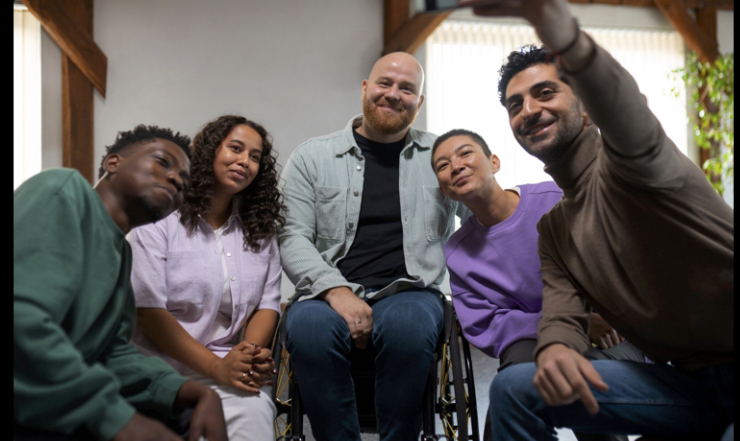Inclusion is a popular term today. It resonates in company value statements, mission goals in schools, and political speeches. It has become an overused word worldwide. Companies announce diversity milestones, and leaders proudly point to the women and minorities they have “included” at decision-making tables. But somewhere along the way, we’ve confused being present with being powerful. We have forgotten that inclusion is not about making a headline or fulfilling a quota—it’s about building systems that don’t just allow people in, but allow them to thrive.
Real, lasting change takes place when people are trusted, heard, and empowered to lead. True inclusion is about what happens behind closed doors, and who gets to shape the conversation. It is therefore an ongoing commitment to building systems where everyone belongs, thrives, and leads.
Image Source: Freepik
The Illusion of Representation
Many institutions love numbers. They announce how many women sit on their boards or how many people of color have joined their leadership teams as part of their achievements. Those figures don’t always translate to power.
- Surface-Level Diversity
Representation can be shallow. An organization can easily hire five new women, but fail when it comes to giving them real decision-making authority. In many African parliaments, for example, women may hold 30% of the seats, but there are not many sitting at the helm and steering the ship.
- Tokenism and Symbolism
Tokenism happens when one person from a marginalized group is showcased as proof of progress but their ideas are sidelined. It’s like inviting someone to dinner but never offering them the menu. A single seat becomes more symbolic than substantial.
This is common on boards or executive teams. One woman or one minority voice is celebrated but left without real support or authority. In the tech space, especially across West Africa, women are often visible in branding campaigns but invisible in technical decision-making. According to a 2023 report by the African Union Commission, women occupy only 16% of leadership roles in African ICT firms. The result is clear: presence without power, visibility without voice.

Image source: Pexels
Redefining Inclusion
We need to rethink what inclusion looks like. More than filling seats, it’s about how we treat those who occupy them.
Four Pillars of Real Inclusion
Real inclusion is built on four ideas: voice, access, respect, and agency. That means:
- People are encouraged to speak and are actually heard.
- They can access the same tools and networks as others.
- Their dignity is never questioned.
- They have the freedom to lead, not just follow.
Psychological safety is of prime importance. People do better in spaces when they know they won’t be punished for speaking up or judged for being different. Inclusion doesn’t mean everyone has to act the same. Acting in accordance with the dominant culture is not required to fit in. They can be accepted just the way they are, with their different accents and “difficult-to-pronounce” names.
Organizations should try and build an ecosystem around this. If teams are global, they must be structured to welcome different identities. Young people and women truly require a sense of belonging. A sure-shot way to embed diversity into systems—not just limit them to slogans—is a mix of various ethnicities in the workplace.
Barriers to True Inclusion
Why is genuine inclusion so hard? The simple answer is that many of the challenges are deep and often invisible.
Cultural and Structural Bias
Tenets that shape power include: gendered roles, colonial mindsets, and ageism. Oftentimes, people think that assertiveness is what leadership is about, especially in workplaces; empathy is considered a weakness. Owing to this, women and people from cultures that value collaboration over competition often find themselves at a disadvantage. Additionally, In many places around the world, leadership is often associated with age and seniority. Young women therefore face a double hurdle: their gender and their youth.
Unconscious Bias and Microaggressions
Unconscious biases within workplaces are deep-seated and present in individually insignificant daily behaviors that add up: either by interrupting someone, crediting their idea to someone else, or questioning their qualifications. Over time, they create a culture where some people shrink and others rise undeservedly.
Inclusion Fatigue and Resistance
Internal backlash towards DEI (diversity, equity, and inclusion) efforts is another major challenge. As companies rush to roll out diversity programs, some employees roll their eyes. Others see inclusion efforts as threats. Performative allyship can have worse impacts than silence. If there is no action, empty efforts won’t make the mark. Without accountability and sincerity, DEI programs risk becoming part of the problem rather than the solution.
Image Source: Pexels
Inclusion in Practice
So, what does real inclusion look like in action? It’s not about celebrations or speeches. It’s about consistent systems that support equity every day.
Inclusive Recruitment and Hiring
It is never wise to hire based on résumés alone. The qualities that need to be looked at center around passion, empathy, and learning ability. People in rural areas need to be reached out to, and young women with no prior work experience should be given a space to nourish themselves. Building flexible career tracks that adjust to people’s lives is what we should be looking for, not the other way around. At Girl Power Talk, women now make up 70 percent of the team.
Leadership That Listens
A team should be willing to learn from each other, no matter the hierarchies. Reverse-mentorship programs, where senior members actively seek feedback and direction from junior teammates, must be encouraged. Let some important campaigns be led by youth; leaving decision-making with younger voices helps nurture accountability. Leadership is not about giving orders, it’s about creating space for others to lead and be heard.
Policies That Empower, Not Police
Invest in flexibility: remote and hybrid work, mental health breaks, and a judgment-free environment around personal responsibilities like motherhood and caregiving. These are not benefits. They’re essentials. Rather than celebrating Women’s Day with flowers, ask women what structural changes they need to grow, and then make those changes.
Mentorship and Sponsorship
Mentorship guides. Sponsorship opens doors. Actively connect young team members with mentors across industries and geographies. A transfer of power is critical for first-generation professionals and people from underrepresented communities. Organizations like Girl Power USA are working to bridge exactly these gaps. Here, platforms are actively created for young women and marginalized individuals where they are championed into leadership.
Building Allyship Ecosystems
Inclusion isn’t a solo act. Engage men, senior leaders, and peers as allies. Run workshops on listening, understanding privilege, and embracing intergenerational cooperation. Allyship doesn’t always equal giving permission. It means stepping aside, making space, and amplifying others. With HerConversation, we have built an environment where underrepresented voices can be shared in safe spaces.
Conclusion
Inclusion is not just inviting people to the table, it’s rebuilding the table together. It’s not enough to have representation. We need to redistribute access and opportunity. The work of inclusion must be ongoing, even if it makes people uncomfortable. The roots should be embedded in justice.
- To policymakers: build systems that support long-term inclusion, not short-term metrics.
- To businesses: audit your power structures. Who’s being heard? Who’s being overlooked?
- To individuals and young leaders: speak up, lift others, and practice inclusion.
We will all go further when everyone has a real stake.

Rachita Sharma is a technology entrepreneur, gender rights advocate, and CEO of Girl Power Talk, where she leads initiatives focused on empowerment, gender lens investing, and inclusive career opportunities. She also serves as Chief Marketing Officer at Blue Ocean Global Technology.
Recognized as one of the 100 Inspirational Women of 2021 by SheInspire Magazine, Rachita has received multiple honors, including the Indian Achiever’s Award, Business Elite’s Under 30, and Most Promising Woman in IT. In 2024, she was named a Next Gen Leader at the Empower Her Awards by Dr. Kiran Bedi, and in 2025, her organization was awarded Best Organization for Women Empowerment by Exchange4Media.
Driven by purpose and inspired by Mother Teresa’s ethos of doing “small things with great love,” Rachita remains committed to advancing equity and opportunity for marginalized communities worldwide.






